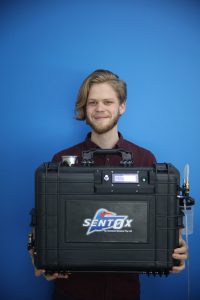Australian engineers have developed a low-cost and accessible oxygen concentrator that will help less-developed countries treat patients with breathing difficulties associated with COVID-19 and other respiratory diseases.
Weighing just 14 kg, the SentOx is rugged, portable, less likely to suffer damage from dust or humidity and aims to cost less than US$500 — a fraction of conventional systems — said lead design engineer Aaron Duivenvoorden, of Sentient Bionics in Port Melbourne.
To date, 10 fully functioning units, designed to World Health Organisation (WHO) specifications, have been shipped to partners in Indonesia and South Africa. In countries such as these, medical equipment can be scarce, expensive and often inaccessible to the disadvantaged.
Designing a device with social benefit
When COVID-19 hit, it was Sentient Bionic’s Director Paul Boxer who asked his young, passionate engineering team to produce a device with real, social benefit.
The WHO predicts 32 million people will require oxygen therapy in the next 18 months. Many of these patients will be in the developing world.

Duivenvoorden, who has a Bachelor of Electrical and Electronic Engineering (Honours) and Business Management from RMIT University, told create that the team “originally looked at providing ventilators and stored oxygen to developing countries.
“But, after conversations with experts around the world, we realised a portable oxygen concentrator was the solution needed,” he said.
Oxygen concentrators use pressure swing adsorption (PSA) technology. They work by compressing air and passing it over porous zeolite, which adsorbs the nitrogen from the air, leaving near pure oxygen that can be fed to the patient through a hose.
SentOx, which delivers oxygen at a constant flow rate of 0 to 10 litres a minute, requires a power source, although it has a backup battery for areas where the power source is unreliable.
“The device takes 12V DC input so can be powered from a vehicle DC source,” Duivenvoorden said.
“We are also currently exploring options for an alternative power supply, such as solar panels.”
The device has a control panel that provides real-time information, including oxygen flow rate, oxygen concentration, unit power status, unit battery level and an audible and visual alarm system to ensure patient safety.
Engineering challenges
When the engineering team began work on the SentOx in March 2020, their proof of concept consisted of bottles of material and valves mounted to a sheet of plywood.
“Our current design is version 2.06, and it took 11 prototypes to get there,” Duivenvoorden said.
“I guess the number of configurations involving different material, system configurations and parameters that we explored as part of engineering testing, though, would number in the hundreds.”
Understanding the effect and significance of parameters like cycle times, internal pressure drops in the system, as well as the impact of differences in input compressor capability, was important in the journey to improving the performance of the SentOx.
“We weren’t trying to reinvent the wheel,” Duivenvoorden said.
“PSA systems have been around for a while, and the Skarstrom cycle that inspired our design is common in our type of concentrator. What we have done differently is focus on a cheap but robust build, and accessible components that allow for easier local manufacture.”
This was achieved with the inclusion of low-cost digital sensors providing real-time information that allow operators to adapt to different conditions and maintain performance.
To overcome maintenance challenges in developing countries, Duivenvoorden said Sentient is willing to develop a complete ‘through life support’ system for the SentOx product, including service parts, training, maintenance schedules and procedures suitable for low-resource environments.
“We are also keen to encourage technology transfer so that SentOx machines can be built and serviced in-country,” he said.
Saving lives
Sentient Bionics is an Australian technology development company incorporated in 2015 to develop innovative, low-cost, robotic hands for prosthetics and robotic research.
It has registered Sentient Oxygen as a not-for-profit charity, with the goal of sending more than 7000 SentOx oxygen concentrators to the developing world in the next 18 months.
To this end, it is working with WHO and the Every Breath Counts Coalition on supply chains and networks. It is also looking for external funding to scale up the project, in-country manufacturers to build more machines.